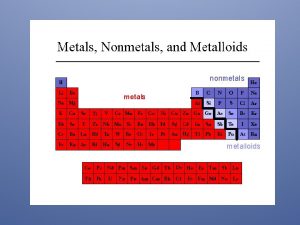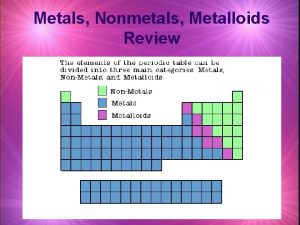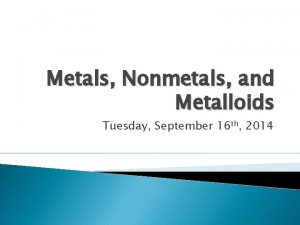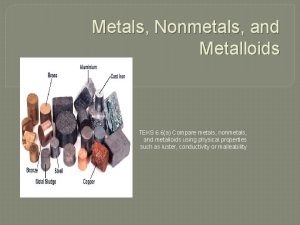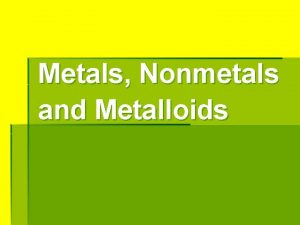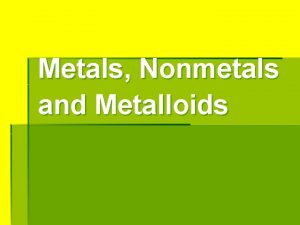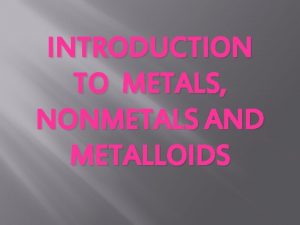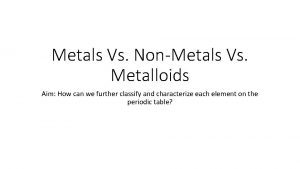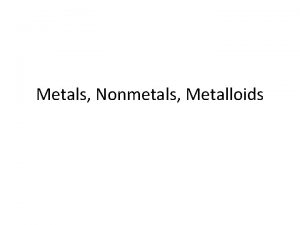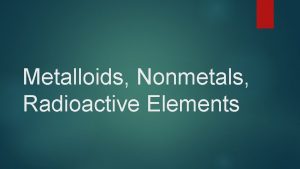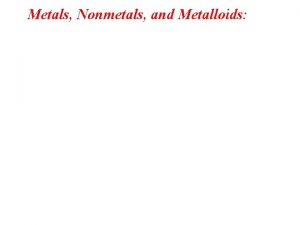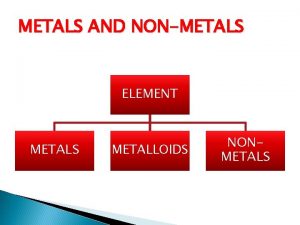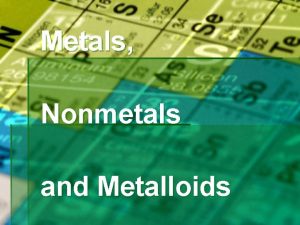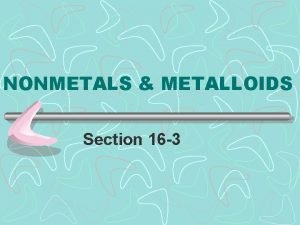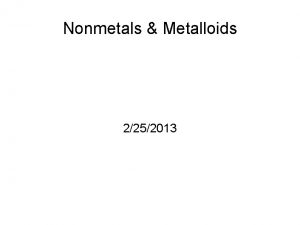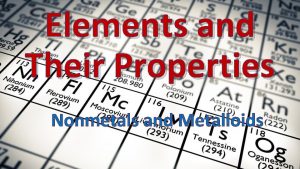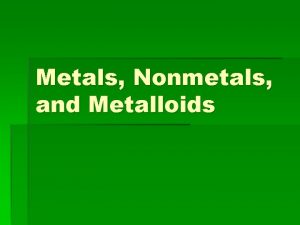Nonmetals and Metalloids What are Nonmetals Nonmetals are











- Slides: 11

Nonmetals and Metalloids

What are Nonmetals? Nonmetals are elements located on the right side of the periodic table Nonmetals do not have any of the properties of metals Examples of nonmetals include: -- nitrogen -- oxygen -- carbon -- chlorine -- argon

Physical Properties of Nonmetals share several common physical properties: -- nonmetals are dull, not shiny -- solid nonmetals are brittle, not malleable or ductile -- if you hammer them, they will break or crumble -- nonmetals usually have lower densities than metals -- nonmetals are poor conductors of heat and electricity

Chemical Properties of Nonmetals The chemical properties of nonmetals are determined by the group (# of valence electrons) of the nonmetal MOST NONMETALS gain electrons (negative charge) when they form ions because their valences shells are close to full When nonmetals form compounds: -- with metals, valence electrons move from the metal to the nonmetal -- with other nonmetals, electrons are shared equally Nonmetals often exist in nature as diatomic compounds -- such as oxygen gas, O 2, or hydrogen gas, H 2 -- (these are two atoms of the same element)

Nonmetal Families The groups (families) of nonmetals are: -- The Carbon Family -- The Nitrogen Family -- The Oxygen Family -- The Halogens -- The Noble Gases Hydrogen is a special non-metal on the left side of the periodic table and is not in any family -- most of the atoms in the universe are of hydrogen -- hydrogen is the only non-metal to lose electrons when forming compounds

The Carbon Family The Carbon family contains all non-metal elements in group 14 (IV) of the periodic table -- the only element in this group is carbon! Carbon is important for several reasons -- it has four valence electrons, so it can bond to up to four other atoms -- all living things are made of carbon -- compounds made out of carbon are called organic compounds

The Nitrogen Family The Nitrogen family consists of all non-metal elements in group 15 (V) of the periodic table -- the two non-metals in this group are nitrogen and phosphorus These atoms have 5 valence electrons Nitrogen is used in living things, and is the most abundant gas in our atmosphere Phosphorus is unstable, so it is only found compounds -- phosphorus is used to make matches and flares

The Oxygen Family The Oxygen family consists of all non-metal elements in group 16 (VI) of the periodic table -- these elements are oxygen, sulfur, and selenium These elements all have 6 valence electrons Oxygen is used as the gas we breathe to live -- also, the ozone layer is made up of O 3 molecules -- it is the most abundant element in earth’s crust and the second-most abundant in our atmosphere -- oxygen is very reactive Sulfur is a yellow, rotten-egg smelling non-metal -- it is used in medicines and plastics

The Halogens are all the non-metal elements in group 17 (VII) of the periodic table -- includes fluorine, chlorine, bromine, iodine, and astatine The halogens have 7 valence electrons and are extremely reactive, wanting to gain the 1 electron needed to complete the valence shell Most halogens are gases that are dangerous to humans Halogen compounds are quite useful: -- fluorine is in non-stick cookware and toothpaste -- chlorine is in many salts -- iodine can be used to purify water

The Noble Gases consist of all elements on the far right (group 18 or VIII) of the periodic table The Noble gases have full valence shells (either 2 electrons for helium or 8 electrons for all others) and therefore are not reactive Noble gases are used in several ways: -- neon is used in signs -- helium is used in balloons -- argon is the 3 rd most abundant gas in our atmosphere

Metalloids There are seven elements classified as metalloids -- boron, silicon, germanium, arsenic, antimony, tellurium, and astatine These are located on the “staircase” between the metals and non-metals Metalloids have some characteristics of metals and others of non-metals The most important use of metalloids is as of “semiconductors”, substances who can change the amount of electricity that they conduct -- based on heat, light, etc. . . -- very useful in computer chips
 Antigentest åre
Antigentest åre Properties of metals nonmetals and metalloids
Properties of metals nonmetals and metalloids Periodic table metals and nonmetals
Periodic table metals and nonmetals What separates metals from nonmetals
What separates metals from nonmetals Nonmetals vs metals periodic table
Nonmetals vs metals periodic table Metals nonmetals and metalloids answer key
Metals nonmetals and metalloids answer key Compare metals nonmetals and metalloids
Compare metals nonmetals and metalloids Metals nonmetals and metalloids difference
Metals nonmetals and metalloids difference Phosphorus color and luster
Phosphorus color and luster Is chalk a metal or nonmetal
Is chalk a metal or nonmetal Metal vs nonmetal
Metal vs nonmetal Periodic table divided in metals nonmetals and metalloids
Periodic table divided in metals nonmetals and metalloids



